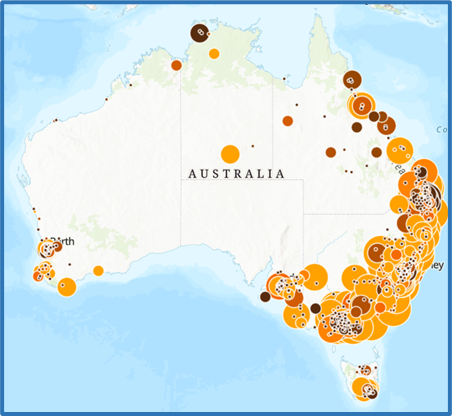AHBIC Industry Update 69
11 April 2025ACT Varroa Detection Varroa mite has been detected in a beekeeper’s hives on a property in the Kowen district of the ACT, very close to the border with NSW. This […]

ACT Varroa Detection
Varroa mite has been detected in a beekeeper’s hives on a property in the Kowen district of the ACT, very close to the border with NSW.
This is the first confirmation of Varroa mite detection in the ACT, although not a surprise, as there have been no movement restrictions between the state of NSW and the ACT since 20 December last year. Beekeepers within the ACT can view heat mapping for the ACT via the DPIRD NSW heat map.
Queensland Varroa Update
Queensland
To date, there has been no confirmed pathway of how varroa entered into Queensland when detected early March this year. Recent surveillance has confirmed further detections in and around the Lockyer Valley and Somerset Council areas, to a total of 20 infested premises.
Biosecurity Queensland’s varroa mite biosecurity zone remains in place. This prevents the movement of bees and live hives from jurisdictions with varroa mite (NSW, ACT & Victoria). These Queensland movement restrictions apply until 28 April 2025 unless removed or changed earlier.
AHBIC reminds beekeepers who have received bees, hives or equipment from the Lockyer Valley since December 2024 to conduct surveillance of their hives and report to the Bee123 portal, or if interstate check your relevant authority: Reporting Varroa.
South Australia
Tracing of movements from the Locker Valley into South Australia have been cleared of any varroa presence by surveillance teams within Primary Industries and Regions South Australia (PIRSA).
The PIRSA – “South Australian Varroa Detection Response and Management Plan” is published online and outlines South Australia’s government response for detections, both outside and within SA and can be found at: South Australia Varroa Program – Detection Response and Transition to Management Plan.
Beekeepers must still apply for an entry permit from QLD into SA. We are told both DPI Queensland and PIRSA are reviewing the current process considering the recent QLD detections and the expansion of Varroa in Eastern States.
Varroa Development Officers
AHBIC successfully advocated for the national distribution of VDO across Australia within the T2M Program and we also fought hard to successfully extend the T2M from 12 to 24 months, including VDO roles.
Although VDOs are employed in government agencies they are funded under T2M via the Emergency Plant Pest Deed, our honey industry is responsible for a 1% share of the full varroa response, and this is funded by all levy paying beekeepers across Australia.
There are 34 VDO across Australia, overseen by AHBIC’s National Varroa Mite Coordinator, Bianca Giggins. The team of VDO are all passionate beekeepers, upskilled in varroa management, best practice beekeeping and ready to improve our industries capacity for the future.
Make sure if you haven’t engaged with the support VDO are offering that you reach out via:

VDO can help beekeepers with planning out how you will manage varroa in a case-by-case scenario treatment plan, tailored for your area, skillset and desired outcomes and are able to elaborate on the complex new skills and knowledge that will become part of your journey living with varroa in the future.
Beekeepers need to be aware that the T2M funding ceases in February 2026, including VDO funding, some of which will cease before February:
|
State/territory |
VDO End Date |
|
NSW & ACT |
Dec 2025 |
|
Victoria |
Dec 2025 |
|
Queensland |
Aug 2025 |
|
South Australia |
Feb 2026 |
| Tasmania |
Jan 2026 |
|
Western Australia |
Feb 2026 |
| Northern Territory |
Jan 2026 |
Table 1: showing cessation of VDO in states and territories across Australia

To view this Update in PDF Click Here
You can reach out to AHBIC via:
National Varroa Mite Coordinator
Bianca Giggins
0402 467 780
AHBIC, its employees, executive and consultants expressly disclaim all and any liability to any person in respect of anything, and the consequences of anything, done or omitted to be done in reliance, whether wholly, partly, upon the whole or any part of the contents of this industry update document.
